Bass is a name shared by many species of fish. The term encompasses both freshwater and marine species, all belonging to the large order Perciformes, or perch-like fishes. The word bass comes from Middle English bars, meaning 'perch'.

Apure State is one of the 23 states (estados) into which Venezuela is divided. Its territory formed part of the provinces of Mérida, Maracaibo, and Barinas, in accordance with successive territorial ordinations pronounced by the colonial authorities. In 1824 the Department of Apure was created, under jurisdiction of Barinas, which laid the foundations for the current entity. In 1856 it separated from Barinas and for the first time Apure appeared as an independent province, which in 1864 acquired the status of state. In 1881, however, a new territorial division combined Apure and Guayana to form a single state named Bolívar. In 1899 it reestablished its autonomy and finally, by means of the Constitution of 1909, gained its current borders.

Gatun Lake is a large freshwater artificial lake to the south of Colón, Panama. It forms a major part of the Panama Canal, carrying ships 33 km (21 mi) of their transit across the Isthmus of Panama.

The Piney Woods is a temperate coniferous forest terrestrial ecoregion in the Southern United States covering 54,400 square miles (141,000 km2) of East Texas, southern Arkansas, western Louisiana, and southeastern Oklahoma. These coniferous forests are dominated by several species of pine as well as hardwoods including hickory and oak. Historically the most dense part of this forest region was the Big Thicket though the lumber industry dramatically reduced the forest concentration in this area and throughout the Piney Woods during the 19th and 20th centuries. The World Wide Fund for Nature considers the Piney Woods to be one of the critically endangered ecoregions of the United States. The United States Environmental Protection Agency (EPA) defines most of this ecoregion as the South Central Plains.
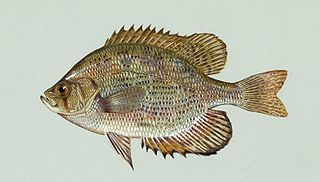
The flier is a species of freshwater ray-finned fish, a sunfish from the family Centrarchidae which is endemic to the southern United States of America. It is the only species in the monospecific genus Centrarchus. A Second World War United States Navy submarine was named the USS Flier after this fish.

The Guadalupe bass is a rare species of fish endemic to the U.S. state of Texas, where it also is the official state fish. It is restricted to creeks and rivers, and is listed as near threatened. Today, most fly fishermen and anglers practice catch-and-release techniques to improve fish populations. The Guadalupe bass is often difficult to distinguish from the smallmouth bass or spotted bass, and the fish is known to hybridize.
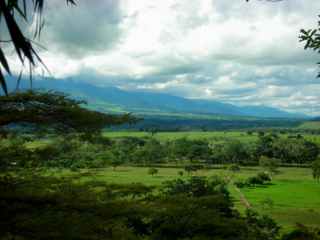
The Llanos is a vast tropical grassland plain situated to the east of the Andes in Colombia and Venezuela, in northwestern South America. It is an ecoregion of the tropical and subtropical grasslands, savannas, and shrublands biome.

Peacock bass (Cichla) is a genus of large cichlids, diurnal and predatory freshwater fish native to the Amazon and Orinoco basins, as well as rivers of the Guianas, in tropical South America. They are sometimes referred to in English by their Brazilian name tucunaré or their Spanish name pavon. Despite the common name and their superficial similarity, they are not closely related to other fish known as bass, such as the North American largemouth bass.

The alligator gar is a ray-finned euryhaline fish related to the bowfin in the infraclass Holostei. It is the biggest species in the gar family, and among the largest freshwater fish in North America. The fossil record traces its group's existence back to the Early Cretaceous over 100 million years ago. Gars are often referred to as "primitive fishes", or "living fossils" because they have retained some morphological characteristics of their early ancestors, such as a spiral valve intestine, which is also common to the digestive system of sharks, and the ability to breathe both air and water. Their common name was derived from their resemblance to the American alligator, particularly their broad snouts and long, sharp teeth. Anecdotal evidence suggests that an alligator gar can grow up to 10 ft (3.0 m) in length.
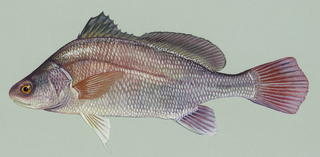
The freshwater drum, Aplodinotus grunniens, is a fish endemic to North and Central America. It is the only species in the genus Aplodinotus, and is a member of the family Sciaenidae. It is the only North American member of the group that inhabits freshwater for its entire life. Its generic name, Aplodinotus, comes from Greek meaning "single back", and the specific epithet, grunniens, comes from a Latin word meaning "grunting". It is given to it because of the grunting noise that mature males make. This noise comes from a special set of muscles within the body cavity that vibrate against the swim bladder. The purpose of the grunting is unknown, but due to it being present in only mature males and during the spawning season, it is assumed to be linked to spawning.

Cichla ocellaris, sometimes known as the butterfly peacock bass, is a very large species of cichlid from South America, and a prized game fish. It reaches 74 cm (29 in) in length. It is native to the Marowijne and Essequibo drainages in the Guianas, and the Branco River in Brazil. It has also been introduced to regions outside its natural range, but some uncertainty exists over the exact identity, and at least some of the introductions may involve another Cichla species or hybrids. It is frequently confused with C. monoculus. Studies conclude that the introduction of Cichla ocellaris does not negatively impact fish communities in Florida, making it an effective fisheries management tool.
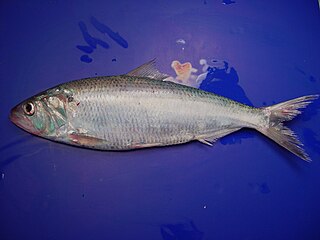
The hickory shad is a member of the herring family Clupeidae, ranging along the East Coast of the United States from Florida to the Gulf of Maine. It is an anadromous fish species, meaning that it spawns in freshwater portions of rivers, but spends most of its life at sea. It is subject to fishing, both historic and current, but it is often confused with or simply grouped together with catch statistics for American shad.
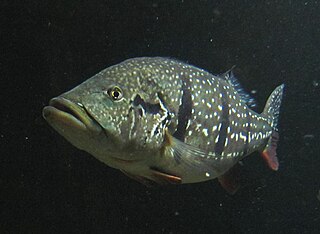
Cichla temensis, the speckled pavon, speckled peacock bass, painted pavon, or three-barred peacock bass, is a very large South American cichlid, and a prized food and game fish. Reaching up to 1 m (3.3 ft) in length and 13 kg (29 lb) in weight, it is the largest cichlid of the Americas, and perhaps the largest extant cichlid in the world, with only Tanganyika's giant cichlid, Boulengerochromis microlepis, reaching similar proportions.

Capanaparo River is a river of Colombia and Venezuela. It is part of the Orinoco River basin. In Venezuela together with the Cinaruco River, other smaller rivers and the area around them they form the Santos Luzardo National Park since 1988.

The blueback herring or blueback shad or summer shad is an anadromous species of herring from the east coast of North America, with a range from Nova Scotia to Florida. Blueback herring form schools and are believed to migrate offshore to overwinter near the bottom.

The redspotted sunfish is a species of freshwater ray-finned fish, a sunfish from the family Centrarchidae which is native to the United States.
Lee Fitzgerald is Professor of Zoology and Faculty Curator of Amphibians and Reptiles in the Department of Wildlife and Fisheries Sciences at Texas A&M University. His biological specialty is the evolutionary ecology and conservation biology of amphibians and reptiles (herpetology). Fitzgerald is a former editor of Herpetological Monographs.

Cichla intermedia, the royal peacock bass, is a large species of cichlid found in the Orinoco River basin in Venezuela and Colombia.
















